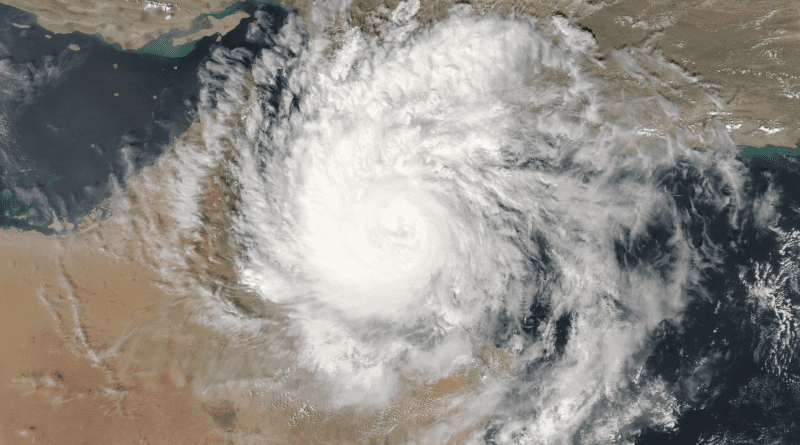Serial Cyclones A Threat To Gulf’s Land Reclamation Projects – Analysis
Cyclone Shaheen this month made its way through the north of Oman and into the Arabian Peninsula’s interior as a dissipating tropical storm. What made this particular cyclone unique was its track: It was way too far north for usual cyclone patterns in this part of the Indian Ocean region.
This tropical depression moved swiftly across the Arabian Peninsula and ultimately reconstituted itself as a series of waterspouts off the Saudi coastline at Jazan. Does Shaheen represent a new cyclone track that threatens Gulf states due to climate change? Or was it the tail end of a singular event traversing sea and land further north than normal? The implications for climate change preparations are paramount.
This Category 1 cyclone entered Oman north of Muscat, producing heavy rainfall and extensive flooding in the sultanate’s lowlands near the coast. Many wadis or canyons flooded, sending torrents of water to lower elevations, contributing to the country’s natural disaster. The Omani authorities’ impressive cleanup operation is ongoing.
Of course, Shaheen was not a new experience for Oman. The worst cyclone in modern Omani history was Gonu in June 2007. This monster Category 5 cyclone slammed Oman with winds at the top of the scale. It killed 50 people and caused extensive damage and flooding, along with power outages that challenged authorities due to the unexpected uncertainty of such a massive weather event.
To their credit, Omani civil defense officials learned fast that a robust reaction capacity would be needed in the future. The country’s ability to clean up after this particular storm was impressive and shows major lessons learned. Omani communities also helped the affected northern areas by sending an aid caravan from the sultanate’s southern Dhofar region.
In May 2018, Cyclone Mekunu hit southern Oman and the Yemeni island of Socotra, killing at least 11 people. It should be noted that Gonu and Mekunu struck much further south than Shaheen in a more typical, historical track. Both storms ended up as tropical depressions in Iran, which was indicative of their northerly travel direction.
Interestingly, Cyclone Shaheen originated in the Pacific Ocean and was a “serial cyclone.” A serial cyclone is a weather phenomenon that travels a great distance, or it can be a series of cyclones that travel over the same area many times as part of its migration pattern. According to research, within the scope of cyclone families, the phrase “cyclone clustering” has been used to describe these periods. But Shaheen represents a different type of beast: One that travels on a new pathway due to shifting temperatures and currents.
For climatologists, a common understanding of cyclone pathways is leading to large cumulative impacts. Shaheen began as Tropical Storm Dianmu, which started in the Western Pacific Ocean and crossed through Vietnam, Thailand and Myanmar as a tropical depression. It then emerged in the Bay of Bengal as Cyclone Gulab and progressed onward to Oman before ultimately producing waterspouts off the west coast of Saudi Arabia. Thus, a serial cyclone from one ocean crossed two land masses and two bodies of water before reconstituting as another cyclone heading for the northern Gulf, ending up as a funnel system in the Red Sea.
Scientists argued that this specific weather phenomenon meant that, hypothetically, the cyclone could have crossed the upper tip of the Arabian Peninsula, passed through the UAE and entered into the Arabian Gulf itself, potentially striking other Gulf states.
Reclaiming land from the ocean can be a useful practice that allows countries to diversify and stimulate their economies, while meeting the demands of a growing human population. But land reclamation in the Gulf may be threatened in the future as a result of climate change. Waves, augmented by dredging and concrete pylons, are also becoming larger and more dangerous.
The short-term impact of such climate change developments is key. The Gulf is like a pond — most if it is less than 35 meters deep. But if more water comes into the Gulf from the Indian Ocean via the Strait of Hormuz as a result of global warming, it will test the resilience of those land reclamation projects. Previously, even a huge storm such as Cyclone Gonu, which caused a massive sea swell, did not test the viability of these colossal projects.
But what may be a bigger problem is a change in rainfall, as demonstrated by the system that gave birth to Shaheen. Future storms may travel further and cause damage where none was expected before. Many of the development projects ongoing around the Gulf could be affected by the growth of new cyclonic tracks. The Shaheen experience is a wake-up call that we should enhance the protection of the current land reclamation projects. We have just got the first taste of what might happen with the next serial cyclone.

